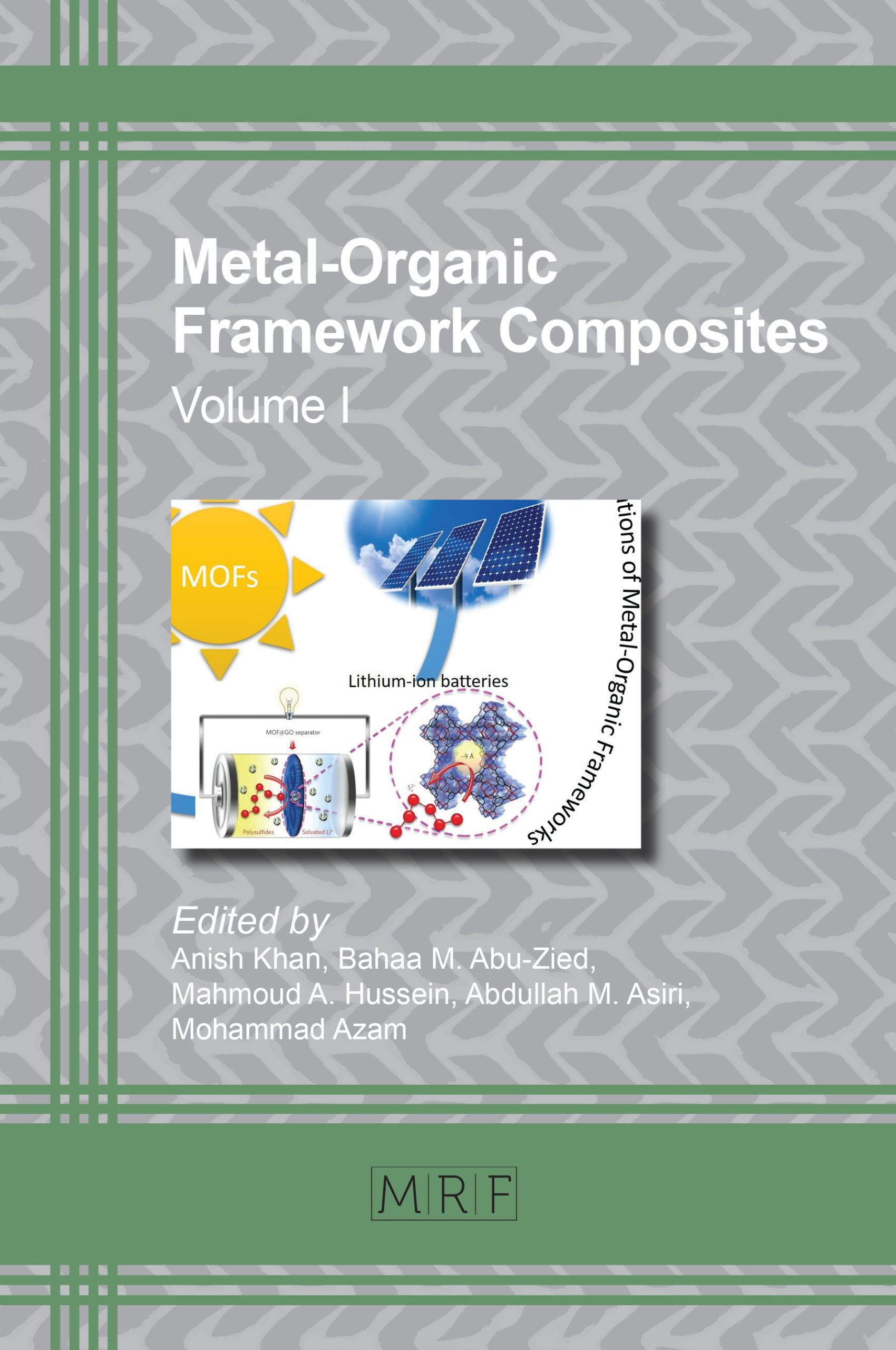High Performance Polymer Fibre-Metal Matrix Composites of Metal-Organic Frameworks – Metallization, Processing, Properties and Applications
D. Kumaran, K. Padmanabhan, and A. Rajadurai
Metal-Organic Frameworks (MOFs) are increasingly being applied in space, automotive, electronic and aerospace applications. In this chapter, high performance engineering polymeric fibres are demonstrated to not only reinforce low melting metals and alloys due to their superior mechanical properties, high thermal resistance up to about 650 °C and resistance to corrosive environment but also light weight resulting composites by reducing the densities. High-performance polymer fibres have superior mechanical properties like specific strength and stiffness that enable them for structural applications. Though high-performance polymer fibres like Kevlar and Zylon were developed two to three decades back, they were still not used as a reinforcement in metal matrix composites, but were used only with other polymer matrices, which generally have good wettability and low processing temperature which are sufficiently low enough not to degrade the reinforcing polymers but also provide cost effective product level solutions with superior performance. Some of the reasons for not using high-performance polymer fibres as a potential reinforcement in metallic materials are their low wettability, poor interfacial properties, and low degradation or heat distortion temperatures in relation to the metal matrix, when processed by conventional manufacturing processes. This chapter presents techniques of metallizing the high-performance polymer fibre surfaces for compatibility with the metallic matrices, using techniques such as electroless coatings, Radio Frequency (RF) ion sputtering and High Velocity Oxygen Fuel (HVOF) thermal spray processes. The metallic coatings improve the wettability of the polymer fibre with the metal matrix and protect the fibre from high thermal gradients that arise during processing. Thus superior thermo-mechanical properties are seen to result from the novel method. The need to process such metal-polymer composites are that the evaluated mechanical properties are comparatively superior to ceramic-metal or glass-metal composites with considerable weight savings over these materials. The corrosion and hygrothermal resistance can be accurately designed to suit the expected durability. This chapter also presents metal-polymer composites made by the HVOF thermal spray technique with low melting metallic matrices. This technique employing additive manufacturing by incorporating high-performance polymers as reinforcements, is the first of its kind in reported literature. It was found that electroless coatings, and RF ion sputtering of copper metal on high-performance polymers, HVOF thermal spray of aluminium on Zylon fibres are effective ways of metallizing organic high-performance polymer fibres. However, the coating thickness optimization for the desired properties are case specific and method specific. The metallized polymers can be used as reinforcements for thermal-structural applications or as function members in radiation shielding. The high-performance polymer reinforced metal matrix composites can thus be used for structural, thermal, electrically conducting and lightning applications in aerospace, automotive and marine domains with considerable weight savings and performance superiority that save energy consumption.
Keywords
Metal-Organic Frameworks, High-Performance Polymers, Metal Matrix, Reinforcement, Metallization, Thermal Spray, HVOF
Published online 6/30/2019, 17 pages
Citation: D. Kumaran, K. Padmanabhan, and A. Rajadurai, High Performance Polymer Fibre-Metal Matrix Composites of Metal-Organic Frameworks – Metallization, Processing, Properties and Applications, Materials Research Foundations, Vol. 53, pp 105-121, 2019
DOI: https://doi.org/10.21741/9781644900291-5
Part of the book on Metal-Organic Framework Composites
References
[1] J.E. Mark, Polymer Data Handbook, Oxford University Press, 1999.
[2] P.M. Hergenrother, ‘The Use, Design, Synthesis, and Properties of High Performance/High Temperature: an overview’, High Performance Polymers, 15 (2003) 3-45. https://doi.org/10.1177/095400830301500101
[3] T. Kitagawa and K. Yabuki , Jl. Polym. Sci: Part B, Polymer Physics, 38(2000) 2901-2911.
[4] T. Kitagawa and K. Yabuki , Jl. Polym. Sci: Part B, Polymer Physics, 38 (2000) 2937-2942.
[5] S. Pourhosseini, H. Beygi, & S.A. Sajjadi , ‘Effect of metal coating of reinforcements on the microstructure and mechanical properties of Al-Al2O3 nanocomposites, Materials Science and Technology,34 (2018) 145-152. https://doi.org/10.1080/02670836.2017.1366708
[6] D. Kumaran , K. Padmanabhan , A. Rajadurai , Design and Fabrication of High Strength, High modulus Polymer Reinforced Metal matrix Composites For Light Weight Applications, Indian journal of Science and technology, 9 (2016) 42. https://doi.org/10.17485/ijst/2016/v9i42/103304
[7] M. Radoeva, M. M. Monev, I.T. Ivanov, G.S. Georgiev, B. Radoev, ‘Adhesion improvement of electroless copper coatings by polymer additives’, Colloids and Surfaces A: Physicochemical and Engineering Aspects, 460 (2014) 441-447. https://doi.org/10.1016/j.colsurfa.2014.02.003
[8] M. Matsuo, H. Ishikawa, Y. Xi, Y. Bin, ‘High modulus and high strength fibers with high electric conductivity prepared by copper electroless plating on the surface of poly (p- phenylenebenzobisoxazole) (PBO)’, Polymer Journal, 39.4 (2007) 389-396. https://doi.org/10.1295/polymj.pj2006161
[9] H.K. Lee, J.Y. Hur, H.N. Lee, C.M Lee, ‘Sn-Ag two step activation process for electroless copper plating. 2. Experimental Procedures’, Latest Trends in Environmental and Manufacturing Engineering, (2012) 135-137. https://doi.org/10.1080/00218469008030185
[10] A.N. Gent, C.W. Lin, ‘Model Studies of the Effect of Surface Roughness and Mechanical Interlocking on Adhesion’, The Journal of Adhesion, 32 (1990) 113-125.
[11] P. Fauchais , ‘Understanding plasma spraying: an invited review’, Journal of Physics D: Applied Physics, 37(2004) 86-108.












